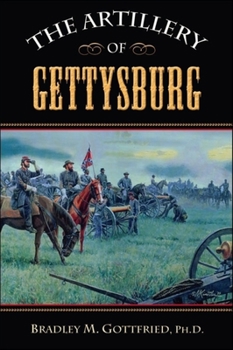The Artillery of Gettysburg
Select Format
Select Condition 
Book Overview
The battle of Gettysburg in July 1863 marked the turning point of the American Civil War. The apex of the Confederacy's final major invasion of the North, the devastating defeat also marked the end of the South's offensive strategy against the North. From this battle until the end of the war, the Confederate armies largely remained defensive. The Artillery of Gettysburg is a thoughtful look at the role of the artillery during the July 1?3, 1863 conflict. Bradley M. Gottfried provides insight into how the two armies employed their artillery, how the different kinds of weapons functioned in battle, and the strategies for using each of them. He shows how artillery affected the ebb and flow of battle for both armies and thus provides a unique way of understanding the strategies of the Federal and Union commanders.
Format:Paperback
Language:English
ISBN:168442187X
ISBN13:9781684421879
Release Date:March 2008
Publisher:Cumberland House Publishing
Length:332 Pages
Weight:1.26 lbs.
Dimensions:0.7" x 6.0" x 9.0"
Customer Reviews
2 ratings
Familiar Battle, Unique Perspective
Published by Thriftbooks.com User , 17 years ago
Bradley Gottfried has written a number of books on Gettysburg, many of which are standard works on the battle. He frequently writes for Gettysburg Magazine and is on very firm ground when writing about the battle. He continues displaying his knowledge with very readable prose in this book. Artillery is the major killer on a battlefield. The long arm reaches out and strikes targets well beyond rifle range. In doing so, they break up attacks, punish the defeated and suppress other batteries. Artillery is hard work, more so when the muscles of horses and men have to do all the work. The movement and handling of guns is the story of those men and horses. This is their story at Gettysburg. The larger issue of training of supply and quality of shells is left to other works. This is the correct decision, as we want to see how the batteries fought on the field not how they were supplied and trained. I should like this book more! I enjoy reading about Gettysburg, I enjoy reading Gottfried but the subject just is not one the deeply interests me. This has to be a technical book and the author works to keep these details to a minimum. However, the number of guns, the type of guns, how they were positioned and where the cessions go are critical to the story. The author does a great job of making this as readable as possible but it just does not capture my imagination. Having said that, I am better informed for working my way through the book. I have a greater understanding of how the two armies controlled their artillery and how that determined the outcome of the battle. This book covers what is usually ignored or only hinted at. As the title says, the book is a unique perspective on a very familiar story.
Solid shot at a vital component of a great battle
Published by Thriftbooks.com User , 17 years ago
Bradley Gottfried's "The Artillery of Gettysburg" is a solid account of the part that artillery, both Union and Confederate, played during the Battle of Gettysburg. The story of the battle is narrated in a straigtforward chronological fashion, with the role of each artillery unit described in turn, detailing how each battery acted and reacted to the avalanche of events during the three days of fighting. If the book has any weakness, it is that the focus is on the tactical experience of artillery batteries in this single battle, without extensive discussion of the technical or organizational aspects of that arm. But, the detailed history, accompanied by numerous maps, allows the interested reader to clearly grasp the vital successes and disappointing failures of Northern and Southern artillery in what is usually considered the greatest battle of the American Civil War.






